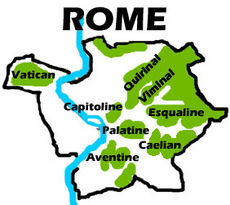Mystery Babylon
|
And there came one of the seven angels which had the seven vials, and talked with me, saying unto me, Come hither; I will shew unto thee the judgment of the great whore that sitteth upon many waters: So he carried me away in the spirit into the wilderness: and I saw a woman sit upon a scarlet coloured beast, full of names of blasphemy, having seven heads and ten horns. And upon her forehead [was] a name written, MYSTERY, BABYLON THE GREAT, THE MOTHER OF HARLOTS AND ABOMINATIONS OF THE EARTH. (Revelation 17:1,3,5) And the woman which thou sawest is that great city, which reigneth over the kings of the earth. (Revelation 17:7) |

Babylon: A city by another name
Revelation 11:8 says, “the great city, which spiritually is called Sodom and Egypt, where also our Lord was crucified.” This scripture is speaking of Jerusalem physically, but revealing its underlying immorality. When the book of Revelation speaks of Babylon, it is identifying the spiritual failures of historical Babylon - confusion, anti-god, idol worship – but is speaking of another city: Rome.
Rome: Sitting on Seven hills
|
I saw a woman sit upon a scarlet coloured beast…having seven heads (Revelation 17:3 compressed) The seven heads are seven mountains, on which the woman sitteth.’’ (Revelation 17:9) |
The Seven Hills of Rome east of the Tiber form the heart of Ancient Rome. The original city was held to have been founded by Romulus on the Palatine Hill, and the other six hills are now called the Aventine, Capitoline, Quirinal, Viminal, Esquiline, and Caelian. The independent settlements on these hills began to unify into what is now known as Rome as the marshes between the hills were drained, and as inter-settlement religious games began to be held.
The Identity of the Woman
|
And the woman which thou sawest is that great city, which reigneth over the kings of the earth.’’ (Revelation 17:18) |
William Branham stated that
- A woman in the Bible always represents the church. Christ is coming for an espoused virgin. The old prostitute of the Bible was called "the church setting on the seven hills," the Roman church. Oh, church... [1]
But contrary to what William Branham stated, the Bible does not say refer to "the church setting on the seven hills". What it does say is that "the woman which thou sawest is that great city..."
Jerusalem itself had been pictured as a harlot by both Isaiah[2] and Ezekiel[3]. Likewise Nahum describes Ninevah’s barbarities in terms of “the wanton lust of a harlot, alluring, the mistress of sorceries, who enslaved nations by her prostitution and peoples by her witchcraft”[4]. Similarly Isaiah’s litany over Tyre[5] calls for her to “take up a harp, walk through the city, you forgotten prostitute; play the harp well, sing many a song, so that you will be remembered.”[6] The typing of the city of Rome to a harlot is therefore imagery taken from the Old Testament, something that is common throughout the Book of Revelation.
So William Branham was wrong. A woman in the Bible does not always represent a church - it often represents a city.
Guilty of the Blood of the Martyrs
|
And I saw the woman drunken with the blood of the saints, and with the blood of the martyrs of Jesus: and when I saw her, I wondered with great admiration. (Revelation 17:6) |
Rome persecuted the Christian church relentlessly once it turned on them. In fact, Nero ordered the death of believers in Rome using them as living torches for his infamous garden parties.[7]
Footnotes
- ↑ BUT.IT.WASN'T.SO.FROM.THE.BEGINNING BLOOMINGTON.IL 61-0411
- ↑ Isaiah 1:21
- ↑ Ezekiel 1:15
- ↑ Nahum 3:4
- ↑ Isaiah 23:15–18
- ↑ Gordon D. Fee, Revelation, New Covenant Commentary Series (Eugene, OR: Cascade Books, 2011), 242.
- ↑ Gordon D. Fee, Revelation, New Covenant Commentary Series (Eugene, OR: Cascade Books, 2011), xx.